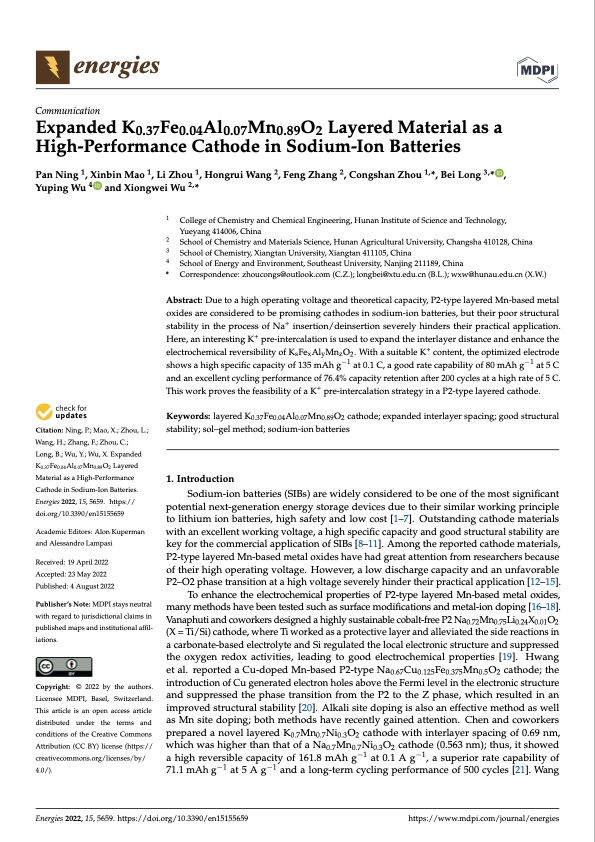
PDF Publication Title:
Text from PDF Page: 001
energies Communication Expanded K0.37Fe0.04Al0.07Mn0.89O2 Layered Material as a High-Performance Cathode in Sodium-Ion Batteries Pan Ning 1, Xinbin Mao 1, Li Zhou 1, Hongrui Wang 2, Feng Zhang 2, Congshan Zhou 1,*, Bei Long 3,* , Yuping Wu 4 and Xiongwei Wu 2,* 1 2 3 4 * Correspondence: zhoucongs@outlook.com (C.Z.); longbei@xtu.edu.cn (B.L.); wxw@hunau.edu.cn (X.W.) Abstract: Due to a high operating voltage and theoretical capacity, P2-type layered Mn-based metal oxides are considered to be promising cathodes in sodium-ion batteries, but their poor structural stability in the process of Na+ insertion/deinsertion severely hinders their practical application. Here, an interesting K+ pre-intercalation is used to expand the interlayer distance and enhance the electrochemical reversibility of KsFexAlyMnzO2. With a suitable K+ content, the optimized electrode shows a high specific capacity of 135 mAh g−1 at 0.1 C, a good rate capability of 80 mAh g−1 at 5 C and an excellent cycling performance of 76.4% capacity retention after 200 cycles at a high rate of 5 C. This work proves the feasibility of a K+ pre-intercalation strategy in a P2-type layered cathode. Keywords: layered K0.37Fe0.04Al0.07Mn0.89O2 cathode; expanded interlayer spacing; good structural stability; sol–gel method; sodium-ion batteries 1. Introduction Sodium-ion batteries (SIBs) are widely considered to be one of the most significant potential next-generation energy storage devices due to their similar working principle to lithium ion batteries, high safety and low cost [1–7]. Outstanding cathode materials with an excellent working voltage, a high specific capacity and good structural stability are key for the commercial application of SIBs [8–11]. Among the reported cathode materials, P2-type layered Mn-based metal oxides have had great attention from researchers because of their high operating voltage. However, a low discharge capacity and an unfavorable P2–O2 phase transition at a high voltage severely hinder their practical application [12–15]. To enhance the electrochemical properties of P2-type layered Mn-based metal oxides, many methods have been tested such as surface modifications and metal-ion doping [16–18]. Vanaphuti and coworkers designed a highly sustainable cobalt-free P2 Na0.72Mn0.75Li0.24X0.01O2 (X = Ti/Si) cathode, where Ti worked as a protective layer and alleviated the side reactions in a carbonate-based electrolyte and Si regulated the local electronic structure and suppressed the oxygen redox activities, leading to good electrochemical properties [19]. Hwang et al. reported a Cu-doped Mn-based P2-type Na0.67Cu0.125Fe0.375Mn0.5O2 cathode; the introduction of Cu generated electron holes above the Fermi level in the electronic structure and suppressed the phase transition from the P2 to the Z phase, which resulted in an improved structural stability [20]. Alkali site doping is also an effective method as well as Mn site doping; both methods have recently gained attention. Chen and coworkers prepared a novel layered K0.7 Mn0.7 Ni0.3 O2 cathode with interlayer spacing of 0.69 nm, which was higher than that of a Na0.7Mn0.7Ni0.3O2 cathode (0.563 nm); thus, it showed a high reversible capacity of 161.8 mAh g−1 at 0.1 A g−1, a superior rate capability of 71.1 mAh g−1 at 5 A g−1 and a long-term cycling performance of 500 cycles [21]. Wang College of Chemistry and Chemical Engineering, Hunan Institute of Science and Technology, Yueyang 414006, China School of Chemistry and Materials Science, Hunan Agricultural University, Changsha 410128, China School of Chemistry, Xiangtan University, Xiangtan 411105, China School of Energy and Environment, Southeast University, Nanjing 211189, China Citation: Ning, P.; Mao, X.; Zhou, L.; Wang, H.; Zhang, F.; Zhou, C.; Long, B.; Wu, Y.; Wu, X. Expanded K0.37Fe0.04Al0.07Mn0.89O2 Layered Material as a High-Performance Cathode in Sodium-Ion Batteries. Energies2022,15,5659. https:// doi.org/10.3390/en15155659 Academic Editors: Alon Kuperman and Alessandro Lampasi Received: 19 April 2022 Accepted: 23 May 2022 Published: 4 August 2022 Publisher’s Note: MDPI stays neutral with regard to jurisdictional claims in published maps and institutional affil- iations. Copyright: © 2022 by the authors. Licensee MDPI, Basel, Switzerland. This article is an open access article distributed under the terms and conditions of the Creative Commons Attribution (CC BY) license (https:// creativecommons.org/licenses/by/ 4.0/). Energies 2022, 15, 5659. https://doi.org/10.3390/en15155659 https://www.mdpi.com/journal/energiesPDF Image | Material as a High-Performance Cathode Sodium-Ion Batteries

PDF Search Title:
Material as a High-Performance Cathode Sodium-Ion BatteriesOriginal File Name Searched:
energies-15-05659.pdfDIY PDF Search: Google It | Yahoo | Bing
Salgenx Redox Flow Battery Technology: Salt water flow battery technology with low cost and great energy density that can be used for power storage and thermal storage. Let us de-risk your production using our license. Our aqueous flow battery is less cost than Tesla Megapack and available faster. Redox flow battery. No membrane needed like with Vanadium, or Bromine. Salgenx flow battery
| CONTACT TEL: 608-238-6001 Email: greg@salgenx.com | RSS | AMP |